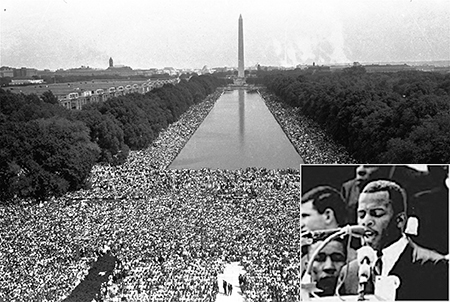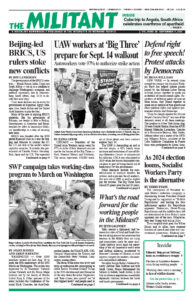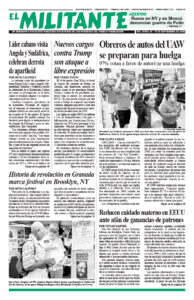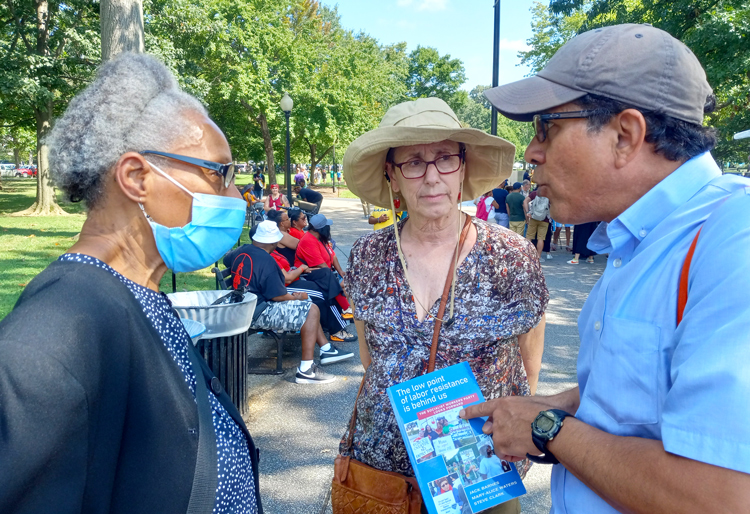WASHINGTON — Over 5,000 marchers turned out here Aug. 26 to mark the 60th anniversary of the 1963 March on Washington. The action was organized by Al Sharpton’s National Action Network and the Drum Major Institute led by the family of Martin Luther King Jr. Other sponsors of the event included the Conference of National Black Churches, the Anti-Defamation League, the NAACP, AFL-CIO, National Organization for Women and the Democratic Party National Committee, among others.
The focus of the event was to try and whip up enthusiasm for campaigning to defeat former President Donald Trump in the 2024 elections and vote Democrat all the way down the ticket. Organizers said “hate crimes, hate speech” are “at their highest levels” and people need to mobilize to counter the “right.”
“The dreamers are in Washington, D.C.,” Sharpton told the rally, “the schemers are being booked in Atlanta, Georgia, in the Fulton County Jail.” He was referring to the indictment of Trump and 18 others on Racketeer Influenced and Corrupt Organizations Act conspiracy charges.

The March for Jobs and Freedom in 1963 drew a quarter of a million people to Washington, reflecting the African American-led working-class movement fighting to overthrow Jim Crow segregation. While the central leaders of that march shared the same pro-Democratic Party political perspective as those here, that protest was marked by the unfolding movement for Black rights and the way it strengthened the union movement.
It came on the heels of bloody conflicts. In June 1963 alone, Medgar Evers, a leader of the NAACP in Mississippi, was assassinated by the Ku Klux Klan; Alabama Gov. George Wallace tried to physically block the integration of the University of Alabama; and thousands of young marchers demanding an end to segregation in Birmingham faced fire hoses and police dogs and won. These developments fueled discussion at the 1963 march on the need to break with the Democratic Party. At that rally, pro-Democratic Party organizers censored the militant speech prepared by John Lewis, president of the Student Nonviolent Coordinating Committee. Still, he was able to tell the crowd, “We can’t vote for the party of [Democrat] Eastland or the party of [Republican] Goldwater. When will we have a party of our own?”
“The march dramatized the readiness of the Negro masses to struggle, to go all the way in the fight,” the Militant wrote at the time. “It also pointed up what the Negro people could do if they had leaders of the same mettle.”
Socialist Workers Party members sold 7,500 copies of the Militant at the march.
Marchers discuss road forward
Among those participating in the rally this year were workers and youth interested in political discussions about what is needed to advance the fights by working people. Some stopped by campaign tables set up by the Socialist Workers Party, picking up the Militant and books written by SWP leaders. Many were drawn by signs that read, “Defend constitutional rights. Drop the charges against Trump.” While many disagreed, many others wanted to discuss and debate these questions.
“I do think Trump is a real problem.” Levon Boxer, a 26-year-old warehouse worker from Nashville, Tennessee, told Róger Calero, SWP candidate for City Council in New York. “But you guys are making a good point here on dropping the charges against him. They will do the same thing to us. And we don’t have a billion dollars.”
“RICO laws are anti-union,” Adam Teller, a member of the International Longshoremen’s Association in Norfolk, Virginia, told SWP campaigners. “The ILA has been the target of numerous investigations by the federal government, and it never did a thing to make the union stronger.”
“Trump just got charged with violating these laws, but I think about how they could be used against me and my union.”
“More workers are using their unions to fight. The decadeslong retreat by the working class has come to an end,” Joanne Kuniansky, SWP candidate for New Jersey State Senate, said. “The bosses and their government target the unions. That’s why it’s absolutely necessary to oppose the Democrats’ assault on constitutional freedoms, whoever is the target today. They’re crucial for the space we need to organize and fight.”
Teller signed up for a Militant subscription and got the book Malcolm X, Black Liberation, and the Road to Workers Power by SWP National Secretary Jack Barnes. He also bought a copy of The Low Point of Labor Resistance Is Behind Us: The Socialist Workers Party Looks Forward by Barnes and SWP leaders Mary-Alice Waters and Steve Clark.
Rally participants included workers involved in union fights from around the country. “Last week, shipyard workers in Maine won a new contract,” Jason Ryder told Kuniansky. He was part of a group of members of Machinists Local S6 from Bath Iron Works, one of the largest military contractors in the country. In 2020, the union waged a hard-fought 63-day strike against boss efforts to bust their union. The company failed in their drive to increase the number of nonunion contract workers in the shipyard and to pit veteran unionists against new hires.
“The union fought for one pay scale for all 4,000 workers,” he said, “and we won!”
“That’s an example to point to, how to win unity and strengthen the union,” Kuniansky said.
“When you fight you can win — maybe not everything you want, but we got more experience,” Ryder said.
SWP’s revolutionary perspective
“The organizers of the rally today argue that white supremacy is on the rise, but that isn’t true,” Kuniansky told those who came to a Socialist Workers campaign meeting held after the march. “The Black-led working-class movement against Jim Crow segregation transformed the country and the working class.”
She pointed to how she and other campaign supporters joined actions with other unionists supporting the Screen Actors Guild-American Federation of Television and Radio Artists National Day of Solidarity four days earlier.
The candidate also participated in a spirited picket line by striking nurses in New Brunswick, New Jersey, who are demanding more staffing. Kuniansky described meeting one Caucasian worker there who carried a Mexican flag he said was given to him at a local restaurant to show support for the strike. “Wide-ranging solidarity can be won for strikes today,” she said.
“The bosses use their government and courts against the working class,” Kuniansky said. “This is why the defense of hard-won constitutional freedoms is so important, and why we demand ‘Drop the charges against Donald Trump.’”
Róger Calero spoke on the accelerating war drive among competing capitalist powers since Putin’s invasion of Ukraine, the first major war in Europe since the inter-imperialist slaughter of World War II.
He pointed to the danger of escalation of the war in Europe, to expanding conflicts with China in the Pacific and growing instability in the Middle East and West Africa. “Frictions around trade and currency wars ultimately lead to shooting wars,” he said, “but they are not inevitable, if the working class has a leadership that organizes us to act in our own class interests.”
There have been two times in history in which the working class has taken power away from the capitalist warmakers. The first was in October 1917, when millions of workers, peasants and oppressed peoples in Russia made the first socialist revolution in the midst of the First World War. The Bolsheviks led workers and soldiers sick of being used as cannon fodder for the capitalist rulers to overthrow the government and established the first workers state.
In the second, Calero said, Fidel Castro led workers and farmers in the millions to conquer power in Cuba, shattering the old state power, and to carry out a revolutionary program to address the needs of working people in city and countryside.
“The SWP is the continuity today of these revolutions,” Calero said. “Our goal is to lead a revolution here.”
Arlene Rubinstein contributed to this article.


